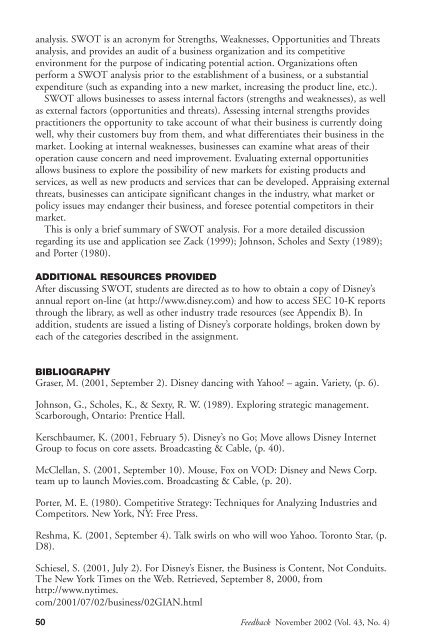Feedback November 2002 (Vol 43 No 4)
Feedback November 2002 (Vol. 43, No. 4) - Broadcast Education ...
Feedback November 2002 (Vol. 43, No. 4) - Broadcast Education ...
You also want an ePaper? Increase the reach of your titles
YUMPU automatically turns print PDFs into web optimized ePapers that Google loves.
analysis. SWOT is an acronym for Strengths, Weaknesses, Opportunities and Threatsanalysis, and provides an audit of a business organization and its competitiveenvironment for the purpose of indicating potential action. Organizations oftenperform a SWOT analysis prior to the establishment of a business, or a substantialexpenditure (such as expanding into a new market, increasing the product line, etc.).SWOT allows businesses to assess internal factors (strengths and weaknesses), as wellas external factors (opportunities and threats). Assessing internal strengths providespractitioners the opportunity to take account of what their business is currently doingwell, why their customers buy from them, and what differentiates their business in themarket. Looking at internal weaknesses, businesses can examine what areas of theiroperation cause concern and need improvement. Evaluating external opportunitiesallows business to explore the possibility of new markets for existing products andservices, as well as new products and services that can be developed. Appraising externalthreats, businesses can anticipate significant changes in the industry, what market orpolicy issues may endanger their business, and foresee potential competitors in theirmarket.This is only a brief summary of SWOT analysis. For a more detailed discussionregarding its use and application see Zack (1999); Johnson, Scholes and Sexty (1989);and Porter (1980).ADDITIONAL RESOURCES PROVIDEDAfter discussing SWOT, students are directed as to how to obtain a copy of Disney’sannual report on-line (at http://www.disney.com) and how to access SEC 10-K reportsthrough the library, as well as other industry trade resources (see Appendix B). Inaddition, students are issued a listing of Disney’s corporate holdings, broken down byeach of the categories described in the assignment.BIBLIOGRAPHYGraser, M. (2001, September 2). Disney dancing with Yahoo! – again. Variety, (p. 6).Johnson, G., Scholes, K., & Sexty, R. W. (1989). Exploring strategic management.Scarborough, Ontario: Prentice Hall.Kerschbaumer, K. (2001, February 5). Disney’s no Go; Move allows Disney InternetGroup to focus on core assets. Broadcasting & Cable, (p. 40).McClellan, S. (2001, September 10). Mouse, Fox on VOD: Disney and News Corp.team up to launch Movies.com. Broadcasting & Cable, (p. 20).Porter, M. E. (1980). Competitive Strategy: Techniques for Analyzing Industries andCompetitors. New York, NY: Free Press.Reshma, K. (2001, September 4). Talk swirls on who will woo Yahoo. Toronto Star, (p.D8).Schiesel, S. (2001, July 2). For Disney’s Eisner, the Business is Content, <strong>No</strong>t Conduits.The New York Times on the Web. Retrieved, September 8, 2000, fromhttp://www.nytimes.com/2001/07/02/business/02GIAN.html50<strong>Feedback</strong> <strong><strong>No</strong>vember</strong> <strong>2002</strong> (<strong>Vol</strong>. <strong>43</strong>, <strong>No</strong>. 4)
















